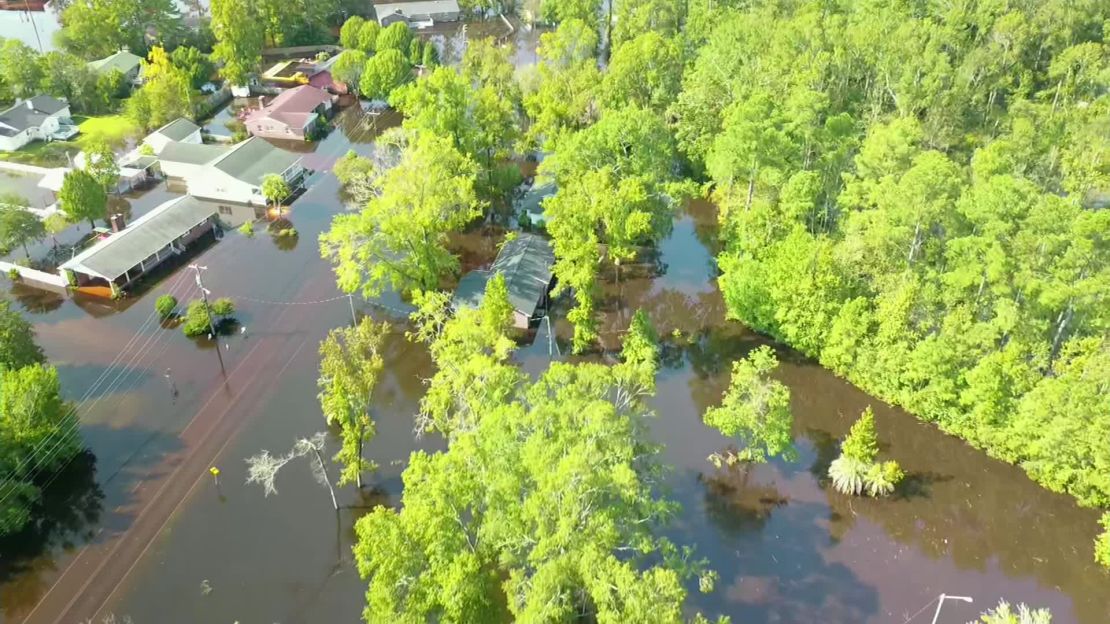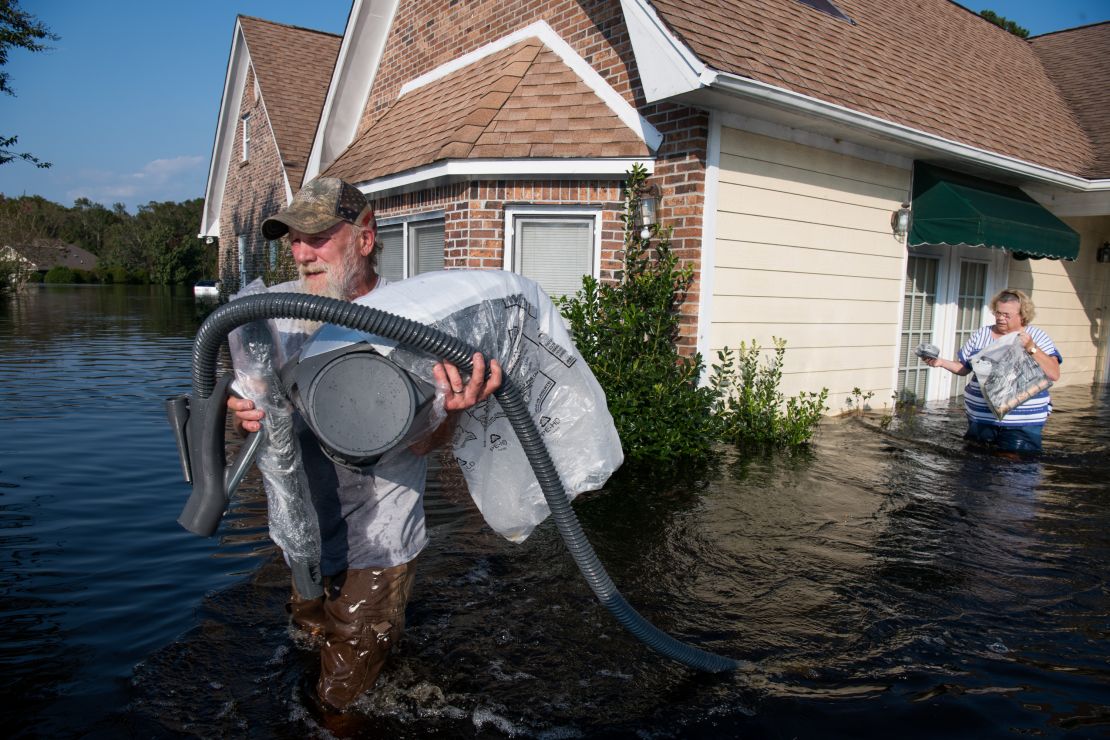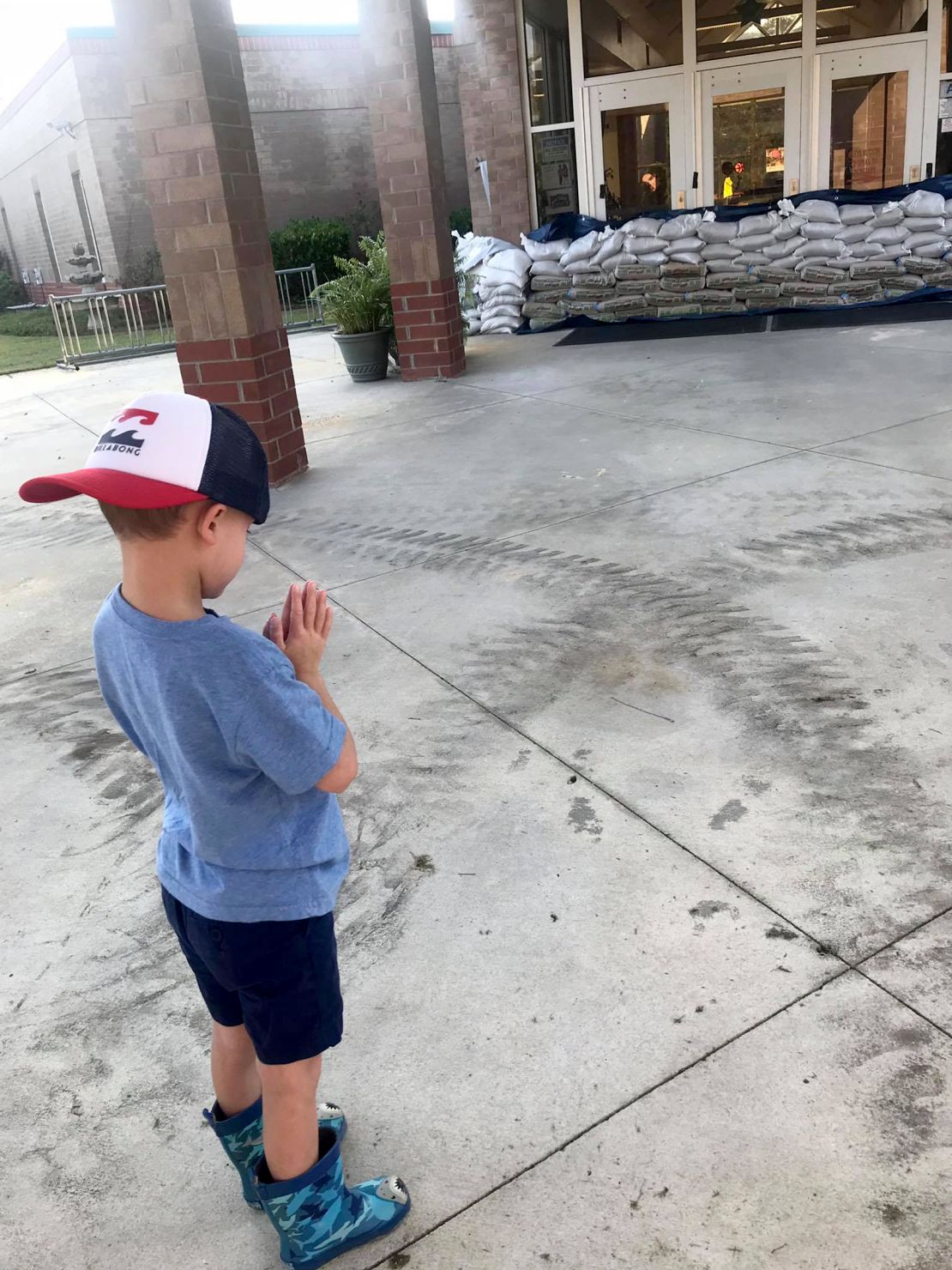Jim Fraboni is preparing for the worst as an “unheard” amount of floodwater from Hurricane Florence is slowly flowing through the Carolinas.
He and his wife have seen floodwater rush in and damage his home for 22 years – but this time feels different. They’ve been moving many of their belongings to the attic, hoping the water won’t rise higher than their house in Horry County, South Carolina.
“This is going to be a lot worse,” Fraboni told CNN affiliate WBTW.
A week after Hurricane Florence made landfall, the trillions of gallons of water it dumped over the Carolinas are slowly moving toward the sea and leaving a path of destruction behind. Residential streets have turned into rivers and freeways have morphed into waterways.
In North Carolina, flooded rivers have left thousands of evacuees still living in shelters and hundreds of roads underwater. The water has receded in some places but as it moves downstream, officials say, thousands of people could be in danger until next week.
“Flooding in North Carolina is sending unheard amounts of water into South Carolina along the Lynches, Great Pee Dee, Little Pee Dee and Waccamaw rivers,” South Carolina Gov. Henry McMaster said in a letter requesting federal aid on Thursday.

“The damage in the northeastern part of our state will be catastrophic, surpassing anything recorded in modern history,” he added.
In a Friday news conference, McMaster said the state’s resources and personnel had shifted to the Pee Dee region.
“Because again, although the winds are gone and the rain’s not falling, the water’s still there and the worst is yet to come in the Pee Dee,” he said.
McMaster estimates the storm recovery will cost about $1.2 billion, according to the letter he sent to the state’s congressional delegation.
Death toll rises
Friday, the total death toll from Florence rose to 44 after two additional deaths were confirmed in Virginia, bringing the number of lives lost in that state to three, and North Carolina’s governor said there was one more death in his state.
In Virginia, one person died in flooding and another died in a motor vehicle accident, according to Jeff Caldwell, spokesman for the Virginia Office of Emergency Management.
The office had previously reported one person was killed during a tornado that was part of the Florence storm system.
North Carolina Gov. Roy Cooper said Friday there were 32 storm-related deaths statewide. The latest death was that of a 46-year-old man in Brunswick County who died when a tree he was cutting fell on him, the governor said.
The South Carolina Department of Public Safety says the statewide death toll is nine. An 81-year-old man who was found dead inside a car in Dillon County after it was swept away by water, was among the victims in South Carolina, the department tweeted on Thursday.
Authorities are also investigating the deaths of two mental health patients in Horry County. The women, Windy Newton, 45, and Nicolette Green, 43, drowned Tuesday in a prison transport van when sheriff’s deputies couldn’t open the doors of the vehicle, authorities said.
McMaster said Friday he had “contacted or attempted to speak personally with the families of everyone who we lost during this crisis, this tragedy,” including the families of Newton and Green.
He warned South Carolinians not to drive over roads covered with water.
“You can never tell what lies under that water,” he said. “The road may be there, it may not be there. Don’t drive across it and if there is a barricade up, do not go around that barricade.”
Half of South Carolina under flood threat
Authorities have said 23 out of the 46 counties in South Carolina could potentially be impacted by flooding. For many residents in those areas it’s not the first time they have been hit by a disaster.
Residents are still recovering from the 2015 catastrophic floods in the Carolinas as well as from the widespread damage of Hurricane Matthew in 2016
In Conway, South Carolina, authorities said residents could see damage in homes that have not flooded before.
“We are worried right now that the water is gonna come up 4 feet higher than Hurricane Matthew levels, which were an all-time record and that’s going to be pretty devastating,” City Administrator Adam Emrick said.

“They need to be prepared no matter how the skies are looking like, the floods are coming. We know it’s coming,” he said.
Water was rising quickly Friday in the Sherwood area of Conway, fire and rescue teams told CNN’s Nick Valencia.
President Donald Trump visited the area earlier this week after floodwaters had receded a bit. Now they’re coming back “at least 3 inches an hour,” one fire and rescue worker told Valencia. “In some places we measured we saw the water rise a foot. It’s rising fast.”

The South Carolina Emergency Management Division said in a release Friday a number of rivers – the Waccamaw, Lynches, Little Pee Dee and Big Pee Dee – are forecast to crest east of Interstate 95 this weekend and early next week.
Residents were warned the confluence of the Big Pee Dee and Little Pee Dee rivers – where they merge – could reach flood levels even greater than those seen during Hurricane Matthew.
Environmental concerns persist
Officials continue to be worried about contamination and environmental hazards resulting from the storm, including the potential impact of coal ash, an industrial waste created by coal-burning power plants that can carry health risks.
Flooding from the Cape Fear River caused breaches in a dam at a cooling lake at Duke Energy’s LV Sutton Plant in Wilmington, North Carolina, on Friday, prompting the company to shut down the natural gas plant, Duke Energy said in a statement.
“Water is now exiting the cooling lake through breaches – one large and several smaller – on the southern end of the impoundment,” the statement said.
It noted there are two coal ash basins on the site, but said there was “no visible ash in the cooling lake.” A landfill containing disposed ash from the site “has not been affected by the cooling lake and repairs from the hurricane are underway,” it added.
An earlier statement from Duke Energy explained the LV Sutton coal power plant was retired in 2013, and today the plant operates as a natural gas plant.
Santee Cooper, a South Carolina electric utility, is installing inflatable dams around a coal ash pond at the former Grainger Generating Station in Conway as the Waccamaw River rises, the company said.
The dam will provide support to the dike around a pond “where most of the ash still onsite remains,” Santee Cooper said in a statement Thursday.
The company noted it has been excavating the plant’s ash ponds since 2014, and has removed about 90% of it.
“The National Guard is on standby if that’s not big enough,” Emrick said of the dam. “We want to make sure the coal ash doesn’t get into the river.”
A 1,000-year rain event – really
North Carolina’s governor called Florence a “1,000-year rain event” for the southeastern parts of the state, and analysis by the National Weather Service has confirmed it wasn’t just a figure of speech.
The NWS tweeted that “3-day rainfall amounts exceeded the 0.1% probability event expected in given year” – meaning, yes, the storm was actually a 1,000-year rain event.

As CNN meteorologist Tom Sater explained in 2015 (during another 1,000-year flooding event in South Carolina), this doesn’t mean the last time this much rain fell on the area was 1,000 years ago, or that the next time will be 1,000 years from now.
A 1,000-year event actually means there was only a 1/1,000 chance that this much rain would fall over 3 days in a year.
Boy prays for floods to spare his school

A young boy turned to prayer when he learned that even more flooding is headed to the Carolinas.
Five-year-old Carter, who goes to kindergarten at Conway Elementary School, was wondering why he hasn’t been to school for the past week.
His dad, Brad Whiteis, told him about Hurricane Florence and explained to Carter the possibility of flooding in the coming days.
When the boy heard that his school could get flooded, he asked his dad whether they could go to his school to pray for it not to flood.
“I wish my faith was always that strong,” Whiteis wrote in a Facebook post about the photo.
CNN’s Nick Valencia, Hollie Silverman and Gisela Crespo contributed to this report.




